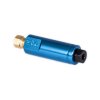Jim B
Active Member
Currently repairing one of my leaky brake lines on Sinister Sally. I originally installed a one inch single remote master like this.

Then I split the line with a tee and used 2 of these 2PSI valves-

One between the master and the front disks and one between the master and rear disks. Do these valves really make a difference or not?

Then I split the line with a tee and used 2 of these 2PSI valves-

One between the master and the front disks and one between the master and rear disks. Do these valves really make a difference or not?




